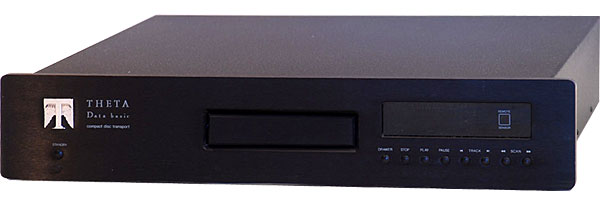| Columns Retired Columns & Blogs |
Theta Data Basic CD transport
It seems to me that it should be possible to make a perfectly jitter-free CD transport without resorting to elaborate, expensive mechanical structures. This idealized transport would ignore all mechanical considerations of disc playback—vibration damping and isolation, for example—and simply put a jitter-free electrical driver at the transport output. If such a circuit could be made, it wouldn't care about how bad the signal recovered from the disc was (provided the recovered data were error-free). The circuit would just output a perfect, jitter-free S/PDIF signal. The result would be the sound quality of the $8500 Mark Levinson No.31 Reference CD transport in $200 machines. Such a scheme would provide an electrical solution to what has been considered largely a mechanical problem.

But back in the real world there's no doubt that attention to mechanical aspects of transport design affects sound quality. Examples abound: listening to Nakamichi's 1000 CD transport with its Acoustic Isolation door open and closed; playing the Mark Levinson No.31 with the top open; and putting any transport on isolation platforms or feet are only a few of the dozens of experiences I have had that suggest that mechanical design is of utmost importance.
But do these examples prove that elaborate mechanical design is a fundamental prerequisite for good transport sound—or only that the currently used electrical output driver circuits are less than perfect?
I suspect we may one day see great-sounding transports at bare-bones prices. But until that day—if it arrives—the stunning new Theta Data Basic transport may be the next best thing.
Technical description
From the outside, the Data Basic looks very similar to the PS Audio Lambda I reviewed in last October's Stereophile (Vol.16 No.10, p.203). The display, functions, and even the front-panel button layout are identical. The main difference is that Theta's disc-loading drawer is in the center of the front panel rather than on the left-hand side.
The Data Basic's front panel is made from 3/8"-thick aluminum. A row of transport control buttons runs underneath the green display. The rear panel holds the standard RCA output jack and a balanced AES/EBU jack; ST-type optical adds $300 to the price, and Theta's Single Mode optical-fiber output costs $800 more. Note that the Single Mode output option requires a Theta processor with Single Mode input (footnote 1). Also note the price change: the Data Basic was first offered for $1500 without AES/EBU output as standard.
The Data Basic and Lambda are even more alike inside. Both use the same display, decoder, transport control, and power-supply boards. The transport mechanisms are also identical. Even the same four chips painted over to obscure their identities in the Lambda have been similarly painted in the Data Basic. It's obvious both are made in the same factory.
There are, however, a few differences. The three power transformers aren't the same, and the Data Basic uses a different brand of filter capacitor on the power-supply board. Other distributed electrolytic caps are different between the two units, and Theta says the other parts are also different. In addition, the board material looks different: the Basic has blue boards, the Lambda's are green. The output timing circuit isn't identical, and the Data Basic uses Theta's custom wire between the pcb and the output jack. Finally, I've been told that the two products are voiced differently.
The main story inside the Data Basic is the huge power supply. It uses three transformers, about 20,000µF of supply capacitance, and 13 regulation stages. Almost every chip has its own power-supply regulation stage to prevent interaction between circuit sections through the power supply. Even the front-panel display has it own transformer. Each transport servo (tracking, focus, rotational) is supplied from a separate regulation stage. The incoming AC is also filtered.
The transport mechanism is the popular Philips CDM9 Pro controlled by a Philips chipset. The CDM9 Pro is an expensive mechanism for a $1750 transport. As with the Lambda, the Data Basic is fitted with the ASM spatial filter—the tiny, doughnut-shaped ring that fits over the objective lens to narrow the aperture. Theta says the spatial filter improves the sound slightly, but meaningfully (footnote 2).
Build quality, overall appearance, and fit'n'finish are outstanding. I like the Data Basic's look more than the Lambda's, although the Lambda's top cover fits its chassis better.
Listening & comparisons
A natural point of comparison for the Data Basic was the similarly priced PS Audio Lambda transport. For an absolute reference, I had on hand the Mark Levinson No.31 Reference CD transport. Digital interconnects included Aural Symphonics Digital Standard (coaxial) and McCormack's new Wonder Link AES/EBU cable. Although the Data Basic review sample was fitted with Theta's Single Mode optical system, I didn't have a processor equipped with a Single Mode receiver. Consequently, the auditioning was restricted to coaxial and AES/EBU.
I wondered just how similar—or different—the Data Basic would sound compared with the nearly identical Lambda. In my review of the Lambda last October, I concluded that it offered terrific performance for the money. From the listening, it was clear that the Lambda and Data Basic resembled each other in their musical presentations yet were decidedly different in other areas. First, the similarities.
Footnote 1: I'll be reviewing Theta's Single Mode transmission system along with the new DS Pro Generation V processor in an upcoming issue.
Footnote 2: ASM's Armando Martinez explained that this is partly due to less back-scattered light making its way through the detector to the laser diode. (This device's output is sensitive to light of the same wavelength falling on it.) The result is said to be a higher carrier:noise ratio and a correspondingly cleaner eye pattern in the data signal.—John Atkinson
- Log in or register to post comments



































